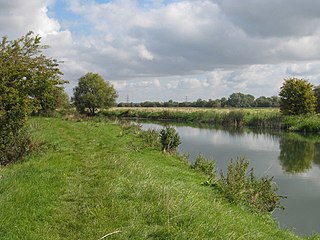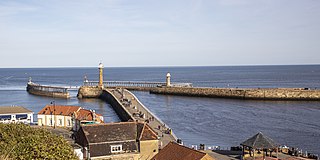
Whitby is a seaside town, port and civil parish in North Yorkshire, England. The town is on the Yorkshire Coast at the mouth of the River Esk. It has a maritime, mineral and tourist economy. The fishing port emerged during the Middle Ages, supporting important herring and whaling fleets, and was where Captain Cook learned seamanship and, coincidentally, where his first vessel to explore the southern ocean, HMS Endeavour was built. Jet and alum were mined locally, and Whitby jet, which was mined by the Romans and Victorians, became fashionable during the 19th century.

Headingley is a suburb of Leeds, West Yorkshire, England, approximately two miles out of the city centre, to the north west along the A660 road. Headingley is the location of the Beckett Park campus of Leeds Beckett University and Headingley Stadium.

Francis Meadow (Frank) Sutcliffe was an English pioneering photographic artist whose work presented an enduring record of life in the seaside town of Whitby, England, and surrounding areas, in the late Victorian era and early 20th century. His documentation of the Victorian and Edwardian periods in Whitby, led him to be labelled as the "pictorial Boswell of Whitby.

Staithes is a seaside village in North Yorkshire, England. Easington and Roxby Becks, two brooks that run into Staithes Beck, form the border between the unitary authorities of North Yorkshire and Redcar and Cleveland. The area located on the Redcar and Cleveland side is called Cowbar. Formerly one of the many fishing centres in England, Staithes is now largely a tourist destination within the North York Moors National Park.

Dunham Massey is a civil parish in the Metropolitan Borough of Trafford, Greater Manchester, England. The parish includes the villages of Sinderland Green, Dunham Woodhouses and Dunham Town, along with Dunham Massey Hall and Park, formerly the home of the last Earl of Stamford and owned by the National Trust since 1976. Dunham Massey is in the historic county of Cheshire, but since 1974 has been part of Trafford Metropolitan Borough; the nearest town is Altrincham. At the 2001 census, the parish had a population of 475.

Worton is a hamlet in Wensleydale in the Yorkshire Dales in the Richmondshire district of North Yorkshire, England. It lies 1-mile (1.6 km) east of Bainbridge on the A684 road, 4 miles (6.4 km) west of Aysgarth and 1-mile (1.6 km) south east of Askrigg. The hamlet is just south of the River Ure, the biggest river in Wensleydale. The hamlet is named in the Domesday Book and its name derives from the Old English wyrt-tūn and means the garden.

Chimney is a hamlet and former civil parish, now in the parish of Aston, Cote, Shifford and Chimney, in the West Oxfordshire district, in the county of Oxfordshire, England. It is on the River Thames near Shifford Lock, 6 miles (9.7 km) south of Witney. Chimney Meadows 620 acres (250 ha) is the largest nature reserve managed by the Berkshire, Buckinghamshire and Oxfordshire Wildlife Trust.

Lealholm is a small village in the Glaisdale civil parish of the Borough of Scarborough, in North Yorkshire, England. It is sited at a crossing point of the River Esk, in Eskdale which is within the North York Moors National Park. It is 9.5 miles (15.3 km) by road from the nearest town of Whitby, and approximately 27 miles (43 km) from both Middlesbrough and Scarborough. The village is typical of those found all across the North York Moors which straddle the main through-routes along the valley bottoms. It is mostly built of local stone with pantiled or slate roofs.

Great Ouseburn is a village and civil parish in the Harrogate district of North Yorkshire, England. It is situated 4 miles (6 km) south-east of Boroughbridge. The village of Aldwark is to the north-east. It had a population of 598 according to the 2011 census.

Lockwood is a civil parish in the unitary authority of Redcar and Cleveland with ceremonial association with North Yorkshire, England. The population of Lockwood ward in the Redcar and Cleveland Unitary authority taken at the 2011 census was 2,022.

Beck Hole is a small valley village in the Borough of Scarborough, North Yorkshire, England. The village lies within the Goathland civil parish and the North York Moors national park.

Beckhole railway station was a railway station at Beck Hole in the North Yorkshire Moors on part of the original Whitby and Pickering Railway line. Although it was possible to travel to Beckhole in 1835, the station was opened in 1836, and closed to passengers permanently in 1914. Beckhole closed completely in 1951.

Rivington in the Borough of Chorley, Lancashire, is situated on the edge of the West Pennine Moors, at the foot of Rivington Pike overlooking reservoirs created for Liverpool Corporation Waterworks in the 19th century. There are twenty eight listed buildings within Rivington, two are classified by English Heritage as Grade II*, the rest as Grade II; Rivington has no Grade I Listed buildings.

Hawsker is the name for the combined villages of High and Low Hawsker that straddle the A171 road 2.5 miles (4 km) southeast of Whitby, in North Yorkshire, England.
Farnley and Wortley is a ward in the metropolitan borough of the City of Leeds, West Yorkshire, England. It contains 45 listed buildings that are recorded in the National Heritage List for England. All the listed buildings are designated at Grade II, the lowest of the three grades, which is applied to "buildings of national importance and special interest". The ward includes the area of Wortley a suburb to the west of the city centre of Leeds, and the area of Farnley. The latter is further to the west, and contains the former village of Farnley, the later village of New Farnley to the south, further to the south the settlement of Upper Moor Side, and the surrounding countryside. Most of the listed buildings are houses, cottages and associated structures, farmhouses and farm buildings. The other listed buildings include churches, the cupola of a previous church, surviving buildings of a former textile mill, a public house, schools, and a war memorial.
Hunshelf is a civil parish in the metropolitan borough of Barnsley, South Yorkshire, England. The ward contains 23 listed buildings that are recorded in the National Heritage List for England. Of these, one is listed at Grade I, the highest of the three grades, and the others are at Grade II, the lowest grade. Apart from the hamlet of Green Moor, the parish is entirely rural. There are remnants of its industrial past in Wortley Top Forge, which is "one of only three water-powered hammer forges surviving in the United Kingdom". This is listed together with associated buildings. Most of the other listed buildings in the parish are farmhouses, farm buildings, and associated structures. The rest of the listed buildings consist of a guide post, a deer paddock, three bridges, and a set of stocks.
Wortley is a civil parish in the metropolitan borough of Barnsley, South Yorkshire, England. The parish contains 25 listed buildings that are recorded in the National Heritage List for England. Of these, one is listed at Grade II*, the middle of the three grades, and the others are at Grade II, the lowest grade. The parish contains the village of Wortley and the surrounding countryside. In the parish is the country house, Wortley Hall, which is listed, together with associated structures and items in the gardens and grounds. The other listed buildings include houses and cottages, two cross bases, a church, a public house, a milestone, and three mileposts.

The piers of Whitby are four structures along the River Esk estuary in Whitby, North Yorkshire, England. Whilst all the piers can be accessed by the general public, the piers were not built as seaside attractions - so called pleasure piers like Redcar, Saltburn or Withernsea, moreover serving a civil purpose, such as ship loading and protecting the harbour. The main West and East piers in the town have been built to provide shelter from the currents and storms of the North Sea, and in the 18th and 19th centuries, any ships seeking refuge in the harbour were charged a levy for use of Whitby's safe haven. These levies were used to pay for the maintenance and improvement of the piers.

Raw is a hamlet in the Borough of Scarborough of North Yorkshire, England, near to the villages of Fylingthorpe, Robin Hood's Bay, and Hawsker. The hamlet is mostly agricultural in nature and it lies 0.5-mile (0.8 km) north-west of Fylingthorpe, 4.5 miles (7.2 km) south-east of Whitby, and due east of the A171 road.
Perlethorpe cum Budby is a civil parish in the Newark and Sherwood district of Nottinghamshire, England. The parish contains 62 listed buildings that are recorded in the National Heritage List for England. Of these, one is listed at Grade I, the highest of the three grades, two are at Grade II*, the middle grade, and the others are at Grade II, the lowest grade. The parish contains the villages of Perlethorpe and Budby, and the surrounding area. The most important and substantial building in the parish is Thoresby Hall, which is listed, together with associated structures, and buildings in the garden and park. Most of the other listed buildings are estate cottages, and the rest include a church and items in the churchyard, private houses, farmhouses and farm buildings, bridges, estate lodges, a pillarbox, former almshouses, a war memorial and a telephone kiosk.




















